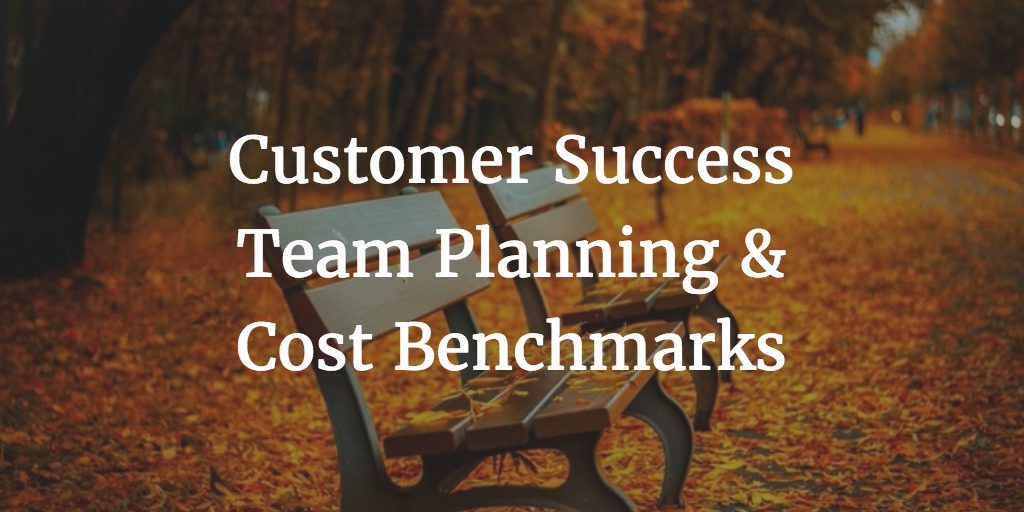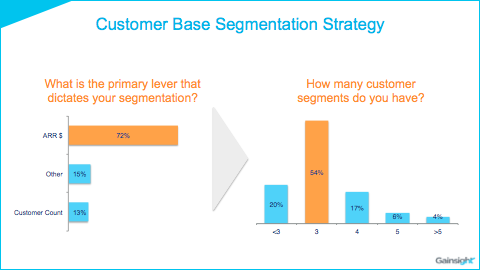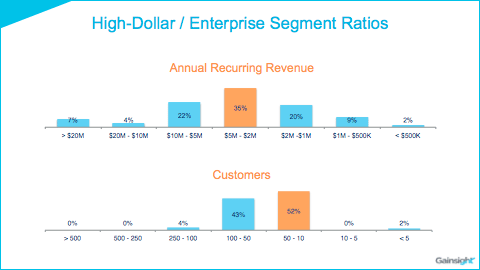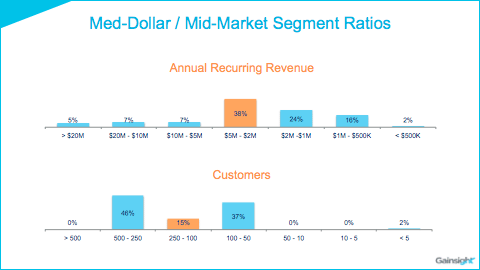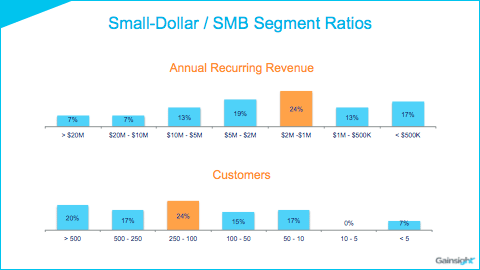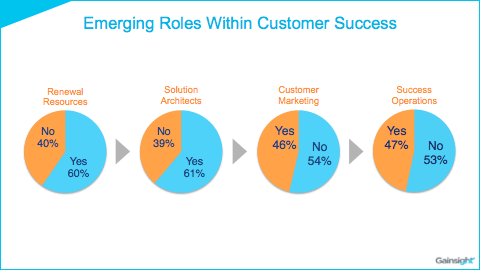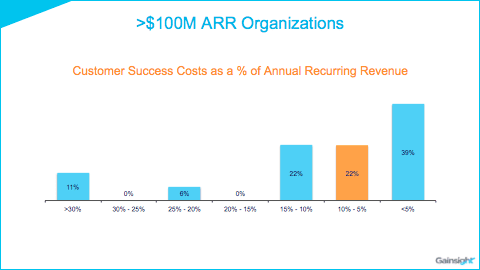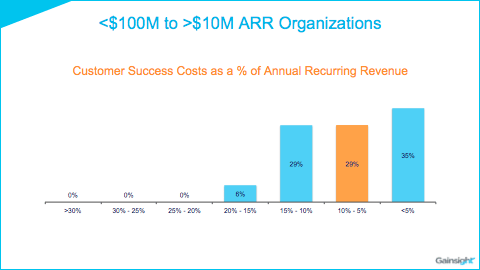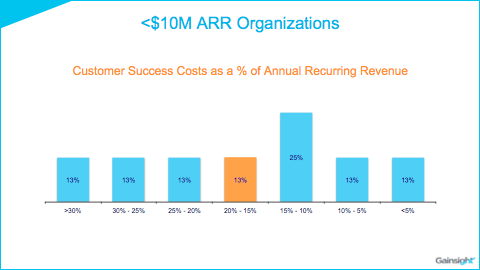In my previous post we dug into how technology companies – large and small, young and old – account for the costs of Customer Success. The feedback we received was very positive, and I appreciated reading every comment note. Thanks! With that said, we kept hearing a similar question among the feedback we received: “It’s great to understand how companies account for the cost of Customer Success, but what should my Customer Success Costs actually be?”
As most Customer Success leaders tend to be much more operations-focused as opposed to accounting-focused, it’s the right question to be asking. Well, we heard you loud and clear! At our recent Chief Customer Officer Summit, I asked a series of survey questions in order to capture these important Customer Success Cost benchmarks.
Before we get into the benchmarks, it’s important to understand both What and How these costs are being deployed. The What is easy: it’s the people that make up your Customer Success Team. The How gets a little more complicated as the CSM workload is different depending on the type of customer the CSM is managing. For this reason, the first question we need to ask as we explore Customer Success Costs is, “How do you segment your customer base?”
Key Takeaways: Segmentation
- The most common lever to segment the customer base is Annual Recurring Revenue (ARR).
- ARR is the best proxy for CSM workload: escalations / meetings / touchpoints / headaches / high-fives are directly related to the size and scale of the customer.
- Slicing the customer base into three segments that dictate CSM workload and the related CSM coverage model is the most common methodology.
CSM Ratios Per Segment
We now know the bulk of the industry thinks about their customer base in three segments: High, Medium and Low-Dollar customers. The next thing we need to understand is how resources are being deployed to drive maximum success across these segments in the most cost-effective manner possible.
Key Takeaways: Enterprise Ratios
- The median amount of ARR that an Enterprise CSM manages is $2M to $5M.
- 69% of Enterprise CSMs manage more than $2M of ARR.
- The median amount of customers an Enterprise CSM manages is 10-50.
Key Takeaways: Mid-Market
- The median amount of ARR a Mid-Market CSM manages is also $2M to $5M.
- 42% of Mid-Market CSMs manage more than $2M of ARR.
- The median amount of customers a Mid-Market CSM manages is 100-250.
- A Mid-Market CSM manages roughly the same amount of ARR as an Enterprise CSM, but it’s spread across many more customers.
Key Takeaways: SMB
- The median amount of ARR an SMB CSM manages is also $1M to $2M.
- 54% of SMB CSMs manage more than $2M of ARR.
- The median amount of customers an SMB CSM manages is between 100-250.
- 37% of SMB CSMs manage more than 250 customers.
Emerging Roles Within The CSM Team
Customer Success Managers will always take up the lion’s share of your total team cost, but we are seeing other very important roles emerging within the Customer Success Team. These roles are not new to the company (with the exception of Customer Success Marketing), but the consolidation of these roles into Customer Success is new, and is continuing to pick up momentum as the ideal Customer Success Team structure.
Key Takeaways: Emerging Customer Success Roles
- Renewal Resources: specialized resources that focus on driving the maximum transaction amount during renewal time. Hiring for this role keeps the CSM as a “strategic advisor” and allows a “sales-minded” resource to drive the renewal negotiation
- This person is typically hired after acquiring more than 150 customers.
- It is a must-have role if the Customer Success Team owns or forecasts the retention and expansion number.
- Solution Architects: specialized resources that focus on technical set-up and on-going customization of the solution.
- These types of resources are typically “floaters” that will help drive a project if the needs are beyond a CSM’s technical capabilities.
- Customer Marketing: responsible for driving all one-to-many communications to the existing customer base.
- This role will continue to grow in prominence; our data shows Customer Success Teams have doubled in prominence over the last 12 months.
- Success Operations: analogous to Sales Operations for the new customer acquisition team, Success Operations is focused on optimizing the activities and processes of the Customer Success Team.
- The Operations role is key once you have invested in a Customer Success platform and your processes mature from reactive or gut-feel to data-driven.
Customer Success Team Costs
The way I’ve been thinking about Customer Success Costs is as a percentage of revenue under management – in short, understanding the team cost in relation to the dollar value of the customer base. In the charts below we are going to dig into Customer Success Cost benchmarks across large (greater than $100M ARR), medium (between $10M and $100M ARR), and small (less than $10M ARR companies). Segmenting the benchmarks by company size normalizes for the differences of scale between companies that are in different revenue size lifecycle stages.
Key Takeaways: Greater than $100M ARR CSM Team Costs
- The bulk of the organizations have Customer Success Teams that cost 10% of ARR or less.
- This is a great benchmark of where your CSM Team Costs should be for a greater than $100M organization.
- 39% have Customer Success Team Costs that are less that 5% of ARR. Very impressive!
Key Takeaways: Between $10M and $100M ARR CSM Team Costs
- There is a pretty even distribution of companies across the last three cost segments.
- If your Customer Success Team Costs are less than 15% of ARR, you are well within industry benchmarks.
Key Takeaways: Less than $10M ARR CSM Team Costs
- Customer Success costs fall across the spectrum at smaller companies.
- Companies are over-investing in Customer Success to protect their most precious asset: their customers.
- If your Customer Success Team Costs are less than 20%, you are within industry benchmarks.
- Keep the faith that your cost as a percentage of ARR will drop as your department matures and the company grows.
Netting It Out
- Segmenting your customer base is key to understanding your workload so you can drive success across a diverse customer base.
- When thinking about ARR and Customer-to-CSM ratios there are lots of factors to keep in mind:
- Financial and strategic value of the customer
- Number of contacts at each customer segment
- The time (per customer, per quarter) that each segment requires
- The expected renewal and retention rate per segment
- As your company matures, the roles beyond Customer Success Manager will need to be filled.
- There is a path to less than 10% Customer Success Team Costs, but it is a long road. Over-investing early is key to ensure success later in the company’s lifecycle.
Learn How Customer Success Plays a Role in Successful Digital Transformation
Now that you have a better understanding of the cost involved with customer success, download our ebook, Customer Success as a Driving Function of Enterprise-Wide Success and Transformation and learn how in today’s ultracompetitive marketplace, businesses of all sizes can’t afford to not make it a priority.
